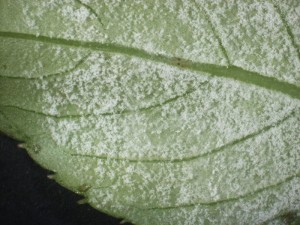
(C) Fotolia.com
Leaves started falling early this year because of the hot dry weather. And, recent freezing temperatures turned many perennials, annuals, vegetables and herbs to mush.
Must be time for fall cleanup.
Start with the worst looking annuals and herbs — impatiens, coleus, sweet potato vine and basil are among the most susceptible to cold temperatures. In the perennial group, hostas most likely took a hit.
It’s best to get these mushy plants cleaned up pretty quickly. A quick cleanup reduces the chance insects and diseases will find save harbor in the soil.

Downy mildew on impatiens leaf. Photo courtesy Purdue University Plant & Pest Diagnostic Laboratory.
This year, gardeners and growers throughout the country battled a fungus called impatiens downy mildew, which turns the underside of the plant’s leaves white or gray.
If this happened to you, do not plant bedding impatiens (I. walleriana) in the same place next year. This disease only affects bedding impatiens. New Guinea and SunPatiens are not bothered by the disease.
Trade off with begonia, torenia, coleus or another annual that tolerates the same low light condition that impatiens loves. Many tropicals, including some gingers, also make good shade plants.
Besides a white mildew on the undersides of leaves, other symptoms include collapsed centers on the impatiens or all of the flowers will be on the tips of the plants. Avoid planting impatiens where there was disease for at least five years. Don’t compost any diseased impatiens.
Next, clean out the frost-damaged tomatoes, peppers and other vegetables. Some veggies, such as lettuce, spinach, broccoli and Brussels sprouts, can usually handle pretty low temperatures. To protect fall vegetables, cover them with a cloth sheet when frost is predicted at night and remove the covering in the morning.
To cut or not to cut
Whether to cut back perennials in fall is a matter of personal preference. Many of them, such as the seed heads of coneflowers and salvias, serve as a food source for birds in winter. Many seed heads also are attractive in the winter landscape.
If the perennials have been diseased or infested with bugs, cut them back and dispose or compost the trimmings. If you are concerned about perennials self-sowing, cut them back.
This is also a good time to apply a 2- to 3-inch layer compost or rotted manure to the vegetable bed and other gardens.